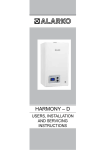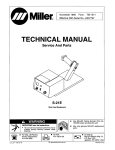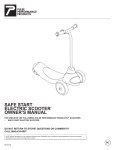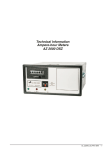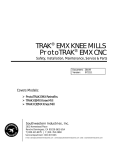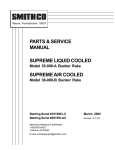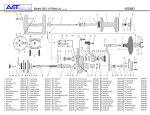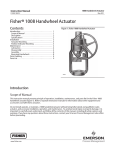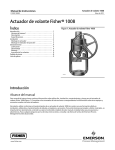Download TECHNICAL SERVICE MANUAL
Transcript
Electronic copies of the most current TSM issue can be found on the Viking Pump website at www.vikingpump.com TECHNICAL SERVICE TECHNICAL SERVICEMANUAL MANUAL ® VI-CORRMAG MAG DRIVE®COMPOSITE COMPOSITEPUMPS PUMPS VI-CORR® DRIVE® SERIES RP805 &&RP807 SERIES RP-805 RP-807 CONTENTS SECTION SECTION PAGE PAGE ISSUE ISSUE TSM 343.1 TSM 343.1 1 of 13 1 Of 13 E C MODEL NUMBER CHART INTRODUCTION SPECIAL INFORMATION INSTALLATION DISASSEMBLY OF MD-A2, MD-A8, MD-B15 or MD-B40 COUPLINGS GENERAL PUMP DISASSEMBLY RP-805 SERIES PUMP DISASSEMBLY RP-805 SERIES PUMP ASSEMBLY RP-807 SERIES PUMP DISASSEMBLY RP-807 SERIES PUMP ASSEMBLY ASSEMBLY OF MD-A2, MD-A8, MD-B15 or MD-B40 COUPLINGS TROUBLESHOOTING DO'S AND DON'S 1 2 2 UNMOUNTED PUMPS 4 8 8 8 9 9 RP-80550 9 11 12 RP-80716 RP-80525 RP-80570 RP-80514 RP-80782 The illustrations in this manual are for identification purposes only and cannot be used for ordering parts. Obtain a parts list from the factory or a Viking® representative. Due to the nature of the pump and the close manufacturing tolerances, certain replacement parts are only available in assemblies. Always give complete name of part, part number or material with model number and series number of pump when ordering repair parts. The pump or pump unit model number and serial number are on the nameplate. In the Viking® model number system, the first number "8" indicates a magnetic coupled design. The next two numbers determine the pump series ad the last two numbers indicate pump size. fIGURE 1 SERIES RP-805 PUMP MOTOR CONNECTED TO FOOTLESS BRACKET AND PUMP VIKINGPUMPINC.• AUnitofIDEXCorporation• D = Direct Drive M = Motor Mounted (Close Coubled C-Flange) B = Bearing Carrier Mounted R = Viking Reducer Drive RP-80724 RP-80732 INTRODUCTION UNITS Units are designated by the unmounted pump model numbers followed by a letter indicating drive style. P = Commercial Reducer Drive (Example RP-80514-MD-A8B) The RP-805 Series gear pumps mount to the MD-A2 or MDA8 coupling. The larger RP-807 Series gear pumps are available with the MD-A2, MD-A8, MD-B15 or MD-B40 couplings. This manual deals only with RP Series composite pumps. Refer to figures 1 thru 20 for general configuration and nomenclature used in this manual. Pump specifications and recommendations are listed in Catalogue Section 343. fIGURE 2 SERIES RP-807 PUMP BEARING CARRIER, FOOTED BRACKET AND MOUNTED PUMP VIKING PUMP, INC. • A Unit of IDEX Corporation • Cedar Falls, IA 50613 USA SPECIAL INfORMATION 3. If a relief valve is not furnished on the pump, some means of over pressure protection such as an in-line relief valve should be provided. DANGER BEFORE OPENING ANY VIKING PUMP LIQUID CHAMBER (PUMPING CHAMBER, RESERVOIR, RELIEF VALVE ADJUSTING CAP FITTING ETC.) BE SURE: 1. THAT ANY PRESSURE IN CHAMBER HAS BEEN COMPLETELY VENTED THROUGH SUCTION OR DISCHARGE LINES OR OTHER APPROPRIATE OPENINGS OR CONNECTIONS. 2. THAT THE DRIVING MEANS (MOTOR, TURBINE, ENGINE, ETC.) HAS BEEN “LOCKED OUT” OR MADE NON- OPERATIONAL SO THAT IT CANNOT BE STARTED WHILE WORK IS BEING DONE ON PUMP. 3. THAT YOU KNOW WHAT LIQUID THE PUMP HAS BEEN HANDLING AND THE PRECAUTIONS NECESSARY TO SAFELY HANDLE THE LIQUID. OBTAIN A MATERIAL SAFETY DATA SHEET (MSDS) FOR THE LIQUID TO BE SURE THESE PRECAUTIONS ARE UNDERSTOOD. FAILURE TO FOLLOW ABOVE LISTED PRECAUTIONARY MEASURES MAY RESULT IN SERIOUS INJURY OR DEATH. 4. If pump rotation is to be reversed during normal operation, pressure protection must be provided on both sides of pump. 5. Relief valve adjusting screw cap must always point towards suction side of pump. 6. Pressure relief valves cannot be used to control flow to regulate pressure. For additional information on pressure relief valves, refer to Technical Service Manual TSM 000 and Engineering Service Bulletin ESB-31. INSTALLATION General The following items must be considered prior to pump installation: 1. Location - locate the pump as close as possible to supply of liquid being pumped. If possible locate pump below liquid supply. Viking pumps are self-priming; but, the better the suction conditions the better the pump will perform. 2. Accessibility - pump must be accessible for inspection, maintenance and repair. 3. Suction/Discharge - SG Series pumps are designed for clockwise rotation as standard (viewed from end of shaft). Refer to Figure 3. Mounting 1. The pump mounting surface must be clean and flat. Rotation: 2. Use SAE Grade 5 or better capscrews to mount pump. Although shaft rotation determines which port is suction and which is discharge, Viking magnetic drive composite pumps are designed to run in a designated direction (indicated on pump decal). DANGER RUNNING THE PUMP IN THE OPPOSITE DIRECTION TO THE DESIGNATED DIRECTION MAY RESULT IN SERIOUS INJURY OR DEATH. Pressure Relief Valves: 1. Relief valves are mounted on the head or casing of all RP series composite pumps. 2. The RP series is a positive displacement pump and requires some sort of over pressure protection. Without over pressure protection, the following is likely to occur: motor stalls, drive equipment fails, a pump part breaks and the piping and/or equipment in the system bursts. This may be an internal relief valve. 3. The mounting capscrews for RP-05 & RP-07 pumps must have a minimum of ½ inch thread engagement. 4. Mechanical Seal and Lip Seals RP Series pumps are designed to be used with jaw type couplings that do not induce axial thrust on the pump shaft. If an improper type coupling is used, internal damage may result. 5. Do not strike or press inner magnet coupling half to install on the pump shaft. Damage to pump or coupling may result if coupling does not slide onto pump shaft, inspect coupling bore, shaft and key for nicks or burrs and remove if present. 6. Once pump has been mounted, place a small amount of compatible liquid into suction port and turn by hand to ensure pump turns freely. Alignment Check alignment after mounting of units with a bearing carrier. 1. If unit has flexible coupling, remove any coupling guards or covers and check alignment of coupling halves. A straight edge (piece of key stalk will work) across coupling must rest evenly on both rims at top, bottom and sides. See Figure 4. 2. Make final check on alignment after piping is hooked up. Replace the guards. TSM 343.1 ISSUE D PAGE 2 OF 13 SECTION TSM 343.1 ISSUE C PAGE 2 Of 13 4. A strainer on the suction side of the pump should always be considered in any pumping system. The straining will keep foreign matter from entering the pump. The strainer mesh or perforation size should be as fine as possible to protect the pump without causing excessive pressure drop. Use of a strainer is particularly important at start up to help clean the system of weld beads, pipe scale and other foreign objects. Clockwise Rotation RP-805 (viewed from shaft end) 5. A pressure relief valve is required in the discharge line. See Pressure Relief Valves, SPECIAL INFORMATION, page 2. USE STRAIGHT EDGE. THESE SURFACES MUST BE PARALLEL CW ROTATION COUPLING ALIGNMENT Clockwise Rotation RP-807 (MD-A) (viewed from shaft end) CW ROTATION Clockwise Rotation RP-807 (MD-B) (viewed from shaft end) fIGURE 3 Piping/Hose The cause of many pumping problems can be traced to suction piping. It should always be as large in diameter and as short in length as possible. Before starting layout and installation of your piping system, consider the following points: 1. Never use piping smaller than pump port connections. Piping larger in diameter than the port connection is sometimes is required to reduce suction losses. 2. Be sure the inside of pipe is clean before installing. 3. When approaching an obstacle in the suction line, go around instead of over it. Going over obstacle creates an air pocket. Where practical slope piping, slope piping so no air or liquid pockets will be formed. Air pockets in suction line make it hard for the pump to prime. CHECK WIDTH BETWEEN THESE SURFACES WITH INSIDE CALIPERS TO BE CERTAIN THE FACES ARE EQUAL DISTANCE APART AND PARALLEL. fIGURE 4 6. Pump must not be used to support piping. Weight of pipe must be carried by hangers, supports, stands, etc. 7. When fastening to the pump to impose any strain on pump casing. "Springing" or "drawing" piping up to pump will cause distortion; possible misalignment and probable rapid wear of pump. Do not use pipe to correct errors in piping layout or assembly. 8. All joints of piping system must be tight; liquid thread sealant will help assure leak free threaded joints. Loose joints result in liquid leaks or suction side leaks. Air leaks make the pump noisy and reduce flow. CAUTION: Be careful not to over tighten fittings as this can cause cracked joints. One full turn beyond hand tight is all that is needed for proper connection. Do not use Teflon tape. Reduced friction makes over tightening very easy and will result in cracked ports. 9. Drive alignment must be checked after piping is hooked up. 10. Provide a pressure relief device if any part of a pump and piping system that can be valved off, thus completely isolated. A rise in temperature will cause liquid to expand. With no provision for pressure relief in the closed off section, there is a chance that the pump or piping will DANGER rupture. BEFORE STARTING PUMP, BE SURE ALL DRIVE Start Up: EQUIPMENT GUARDS ARE ADEQUATE AND IN PLACE. FAILURE TO PROPERLY MOUNT GUARDS MAY RESULT IN SERIOUS INJURY OR DEATH. Before pushing "start" button, check the following: 1. Vacuum and pressure gauges (liquid filled) are mounted on or near the pump. Gauges are the quickest and most accurate way of finding out what is happening in the pump. TSM 343.1 SECTION TSM 343.1 ISSUE C ISSUE D PAGE 3 OF 13 PAGE 3 Of 13 1. Soft face hammer 2. Allen wrenches 2. Check Pump alignment (See page 3). 3. Check piping to be sure there is no strain on the pump casing. 4. 2. Rotate the pump shaft by hand to be Check Pump alignment (See page 3).sure it turns freely. 55. 3. Motor been jogged and isis running Checkhas piping to be sure there no straininonthe thecorrect pump direction. casing. Refer to "General" on page 2. 6. 4. Pressure valve is by installed properly. Rotate therelief pump shaft hand to be sure it turns freely. 7. 55. Suctionhas piping connected tight, and valves are Motor beenis jogged and and is running in the correct open. direction. Refer to "General" on page 2. 8. 6. Make sure discharge piping isproperly. connected and tight, Pressure relief valve is installed valves are open and, and end of shaft is below liquid 7. Suction piping is connected and tight, and valves are level. open. 9. All guards are in place. 8. Make sure discharge piping is connected and tight, 10. The above checklist a general to be liquid used valves are open and,isand end of guideline shaft is below prior to starting pump. Since Viking pump cannot foresee level. every application for our product and possible system 9. All guards areresponsibility in place. design, final is with the user. The pump must be utilized withinisthe catalog specifications andused the 10. The above checklist a general guideline to be pump system must be designed to provide safe working prior to starting pump. Since Viking pump cannot foresee conditions. every application for our product and possible system finalbutton. responsibility is with begin the user. The pump Pushdesign, the "start" Pump should to deliver liquid must be utilized within the catalog specifications and the within 15 seconds! pump system must be designed to provide safe working If theconditions. pump does not deliver liquid, push the stop button. Do not run the pump without liquid flow longer than 30 Push the because "start" button. Pump should begin deliver liquid seconds pump or coupling couldto be damaged within 15 seconds! or ruined. If the pump doesjust not outlined. deliver liquid, push the stop button.and Do Review steps Consider what suction not run the pump without liquid flow longer than put 30 discharge gauges indicate. If everything appears in order, seconds pump or coupling more liquidbecause in the pump suction port. Seecould item 6be on damaged page 3. or ruined. Push the start button. If nothing happens within 30 seconds, stop the steps pump. just The pump is not a compressor and will and not Review outlined. Consider what suction build up much air indicate. pressure.IfIteverything may be necessary vent put the discharge gauges appears intoorder, discharge until liquid beginsport. to flow. Use 6a on safe venting more liquidline in the pump suction See item page 3. procedure especially handling hazardous Push the start button.when If nothing happens withinliquids. 30 seconds, stop pump. The pump is notliquid, a compressor and or willmore not If the the pump still does not deliver consider one build much air pressure. It may be necessary to vent the of theup following: discharge line until liquid begins to flow. Use a safe venting 1. Suctionespecially line air leaks; gauge reading should help procedure whenvacuum handling hazardous liquids. determine if this is the problem. If the pump still does not deliver liquid, consider one or more 2. the Endfollowing: of suction pipe not submerged deep enough in liquid. of 3. Suction is air tooleaks; great vacuum or suction pipingreading is too small. 1. Suction lift line gauge should help determine if this is the problem. 4. Liquid is vaporizing in the suction line before it gets to the pump. 2. End of suction pipe not submerged deep enough in liquid. 4. press 3. Arbor Internal snap ring pliers (for bearing carriers only) 2-810029-047-999 (Truarc No. 0500) 5. Torque wrench 4. External snap ring pliers 2-810-029-375 (Truarc No. 0400) DISASSEMBLY Of MD-A2, MD-A8, 4. 5. Arbor press MD-B15, or MD-B40 COUPLINGS 5. 6. Torque wrench 1. Read all of the instructions before proceeding with disassembly of the coupling and/or pump. Remove DISASSEMBLY Of MD-A2, MD-A8, piping to ports and remove the mounting capscrews MD-B15, or MD-B40 COUPLINGS securing pump to bracket. Support larger pumps with if possible. Remove pump from coupling 1. overhead Read all hoist of the instructions before proceeding with bracket. See FIGURE 6 on pageand/or 4. disassembly of the coupling pump. Remove 2. 2. piping ports and remove mounting capscrews Canisterto will probably be full the of liquid, use care while securing to bracket. Support pumps both with removing pump from pump and pull straightlarger off. Loosen overhead possible. Remove from coupling setscrews hoist and ifpull off inner magnetpump assembly. MD-A2 bracket. Seecouplings FIGURE 6require on page 4. and MD-A8 removing the pipe plug in pump bracket to gain access to liquid, the setscrews Canister will probably be full of use careholding while the inner magnet. removing from pump and pull straight off. Loosen both setscrews andthis pullisoffa inner magnet assembly. Don't forget very powerful magnet. MD-A2 Do not and MD-A8 couplings require removing the pipe plug inremove O-ring on bracket unless you plan to replace pump bracket to gain access to the Follow setscrews holding especially the encapsulated O-rings. instructions the inner magnet. for installation of a new Teflon® in ASSEMBLY encapsulated O-ring. Don't forget this is a very powerful magnet. Do not 3. 3. remove O-ring bracket unlessinspect you plan to replace You should be on able to visually other magnetsespecially thebracket. encapsulated O-rings. Follow instructions from end of If removal is necessary, start by in ASSEMBLY for installation of a from new motor Teflon® removing (4) capscrews and separating or encapsulated O-ring. bearing carrier. Loosen setscrews in outer magnet assembly to pull assembly off shaft. You should be able to visually inspect other magnets from end of bracket. If removal is necessary, start by removing (4) capscrews and separating from motor or bearing carrier. Loosen setscrews in outer magnet assembly to pull assembly off shaft. fIGURE 5 RP-80732 - MD-B15 with motor fIGURE 5 RP-80732 - MD-B15 with motor 5. Suction Magneticliftcoupling is decoupling some 3. is too great or suctionfor piping is reason. too small. PLACE HANDS BACK HERE If after consideration points, line the before pump still does not 4. Liquid is vaporizingofinthese the suction it gets to the deliver liquid, review all points given under START UP and pump. read through the TROUBLESHOOTING guide and try again. 5. Magnetic coupling is decoupling for some reason. If pump still will not deliver liquid, contact your Viking Pump supplier. If after consideration of these points, the pump still does not deliver liquid, review all TOOLS: points given START UP and SUGGESTED REPAIR The under following are required read through the TROUBLESHOOTING guide and try again. to properly repair a RP Series Mag Drive pump. The tools are If stilltowill not deliver liquid, contact your as Viking in pump addition standard mechanics tools such openPump end supplier. wrenches, pliers, screw drivers, etc. Most of the items can be obtained from an industrial supply The house. SUGGESTED REPAIR TOOLS: following are required to a RP Series Mag Drive pump. The tools are 1. properly Soft facerepair hammer in addition to standard mechanics tools such as open end 2. Allen wrenches wrenches, pliers, screw drivers, etc. Most of the items can be obtained from an industrial house.carriers only) 2-8103. Internal snap ring plierssupply (for bearing 029-047-999 (Truarc No. 0500) 1. Soft face hammer TSM 343.1 ISSUE D PLACE HANDS BACK HERE CAUTION: DO NOT PLACE fINGERS HERE AT ANY TIME fIGURE 6 CAUTION: DO NOT PLACE fINGERS Typical Pump Removal from Coupling HERE ATBracket ANY TIME fIGURE 6 Typical Pump Removal from Coupling Bracket PAGE 4 OF 13 4. snap ring pliers 2-810-029-375 (Truarc No. 0400) 2. External Allen wrenches 3. Internal snap ring pliers (for bearing carriers only) 2-810- SECTION TSM 343.1 ISSUE C PAGE 4 Of 13 S SETSCREWS INNER MAGNET ASSEMBLY CANISTER STATIC O-RING fIGURE 7 Typical Pump Assembly BRACKET CAPSCREWS fIGURE 8 Typical Outer Magnet Assembly Bearing Carrier Components M-Drive Close Connected fIGURE 9 Typical MD-2 & MD-8 Coupling Bearing Carrier Components M-Drive Close Connected fIGURE 10 Typical MD-15, MD-25 & MD-40 Coupling ITEM 1 2 3 4 DESCRIPTION Setscrew, Outer Magnet - (2Req'd) Outer Magnet Assembly - (3Req'd) Bracket, Footed or Footless Capscrew for Motor or B.C. - (4Req'd) ITEM 10 11 12 13 DESCRIPTION Bearing Housing Retaining Ring, External - (2Req'd) Bearing Spacer Ball Bearing - (2Req'd) 5 Canister 14 Retaining Ring, Internal 6 7 8 9 Inner Magnet Assembly - (2Req'd) Setscrew, Inner Magnet - (2Req'd) Hex Nut - (4Req'd) Lock Washer - (4Req'd) 15 16 17 18 Shaft Key - (2Req'd for MD-8) key-Inner (for MD-15 thru 40) Shroud, Bracket (MD-15 thru 40) TSM 343.1 ISSUE D PAGE 5 OF 13 TYPICAL RP-805 EXPLODED VIEW fIGURE 11 ITEM DESCRIPTION ITEM DESCRIPTION ITEM DESCRIPTION ITEM DESCRIPTION 1 O-ring 7 #404 Woodruff Key 13 Casing & Bushing 19 Lock Nut, Relief Valve 2 Bracket 8 Driver Shaft 14 Capscrew 20 Cap, Relief Valve 3 Pipe Plug 9 Driven Shaft 15 Poppet, Relief Valve 21 Casing Plug, for Less Relief Valve 4 O-ring 10 Retaining Ring 16 Spring, Relief Valve 5 Separation Plate 11 Drive Pin 17 Adjusting Screw, Relief Valve 6 Spacer Plate & Bushings 12 Gear 18 Gasket, Relief Valve TYPICAL RP-80782 and RP-80716 EXPLODED VIEW fIGURE 12 ITEM DESCRIPTION ITEM DESCRIPTION ITEM DESCRIPTION ITEM DESCRIPTION O-ring, Bracket (A Series) 4 Drive Key 12 Capscrew 20 Flange 1A Bracket & Bushings (A Series Mag Drive) 5 Drive Pin 13 Poppet, Relief Valve Pipe Plug - 1/8" (A Series) 6 Retaining Ring 14 Spring, Relief Valve O-ring, Bracket (B Series) 7 O-ring 15 21 O-ring, Flange 1B Bracket (B Series) 8 16 Gasket, Relief Valve 9 Casing and Gears 17 Lock Nut, Relief Valve 2 Separation Plate and Bushing (B Series) Driver Shaft Separation Plate with Ports and Bushings Adjusting Screw, Relief Valve 10 Alignment Sleeves 18 3 Driven Shaft 11 Head and Bushings 19 Cap, Relief Valve O-ring, Flange to Pump TSM 343.1 ISSUE D PAGE 6 OF 13 SECTION TSM 343.1 ISSUE C PAGE 6 Of 13 TYPICAL RP-80724 and RP-80732 EXPLODED VIEW fIGURE 13 ITEM DESCRIPTION ITEM DESCRIPTION ITEM DESCRIPTION ITEM DESCRIPTION O-ring, Bracket (A Series) Bracket & Bushings (A Series Mag Drive) Pipe Plug - 1/8" (A Series) O-ring, Bracket (B Series) 4 Driven Shaft 12 Alignment Sleeves 20 Cap, Relief Valve 5 Drive Key 13 Head & Bushings 21 O-ring, Flange to PUMP 6 7 Drive Pin Retaining Pin 14 15 Capscrew Poppet, Relief Valve 22 Flange Bracket (B Series) 8 O-ring 16 Spring, Relief Valve Separation Plate and Bushing (B Series) 9 Casing & Gears 17 Adjusting Screw, Relief Valve 23 O-ring, Flange 2 Driver Shaft 10 18 Gasket, Relief Valve 3 Driven Shaft 11 19 Lock Nut, Relief Valve 1A 1B Separation Plate with Port Bushings Casing & Gears INNER MAGNET ASSEMBLY BEARING CARRIER ASSEMBLY CANISTER CANISTER O-RING BRACKET O-RINGS SEPARATION PLATE SHAFT SPACER PLATE BUSHINGS OUTER MAGNET ASSEMBLY CASING BRACKET DRIVER SHAFT SETSCREW MOUNTING CAPSCREW DRIVER GEAR RELIEF VALVE CAP ASSEMBLY CAPSCREW fIGURE 14 TYPICAL SERIES RP-805 WITH MD-A, B DRIVE CUTAWAY VIEW TSM 343.1 ISSUE D PAGE 7 OF 13 DANGER BEFORE OPENING ANY VIKING PUMP LIQUID CHAMBER (PUMPING CHAMBER, RESERVOIR, RELIEF VALVE ADJUSTING CAP FITTING ETC.) BE SURE: 1. THAT ANY PRESSURE IN CHAMBER HAS BEEN COMPLETELY VENTED THROUGH SUCTION OR DISCHARGE LINES OR OTHER APPROPRIATE OPENINGS OR CONNECTIONS. 2. THAT THE DRIVING MEANS (MOTOR, TURBINE, ENGINE, ETC.) HAS BEEN “LOCKED OUT” OR MADE NONOPERATIONAL SO THAT IT CANNOT BE STARTED WHILE WORK IS BEING DONE ON PUMP. 3. THAT YOU KNOW WHAT LIQUID THE PUMP HAS BEEN HANDLING AND THE PRECAUTIONS NECESSARY TO SAFELY HANDLE THE LIQUID. OBTAIN A MATERIAL SAFETY DATA SHEET (MSDS) FOR THE LIQUID TO BE SURE THESE PRECAUTIONS ARE UNDERSTOOD. FAILURE TO FOLLOW ABOVE LISTED PRECAUTIONARY MEASURES MAY RESULT IN SERIOUS INJURY OR DEATH. GENERAL PUMP DISASSEMBLY 4. After pump is apart, inspect all parts for signs of wear. Look carefully at the shaft, bushings, inside of casing, gear teeth, spacer plate, and the inside face of the casing for signs of wear. 5. If replacing shafts, remove retaining rings from both sides of gear. Press gear off shaft and remove drive pin(s) or balls from shaft. 6. Visually inspect the pump O-rings. If the O-rings are Teflon® (appear to be white), it strongly recommended to replace rather than reuse. Do not remove the bracket Oring unless planning to replace, especially if it is an encapsulated O-ring. 7. If pump has relief valve, remove the acorn nut covering the relief valve adjusting screw. Measure the distance of the relief valve adjusting screw to the pump surface and record this length. Finish disassembling relief valve and inspect the seat in the casing and the poppet for signs of wear or foreign matter on either surface. RP-805 SERIES PUMP ASSEMBLY • The pump is ready to be reassembled after all parts have been changed and worn parts replaced. • Use a suitable lubricant compatible with the fluid being handled when reassembling the pump. • Make sure all holes machined in the bracket are clean and that the mating surfaces of each section are free of any dents or burrs. 1. Lubricate bushings in casing. CLOCKWISE PUMP SHAFT ROTATION Place the driven gear and shaft into the casing gear bore opposite the notch in casing face. COUNTER-CLOCKWISE PUMP SHAFT ROTATION Place the driven gear and shaft into the casing gear bore nearest the notch in casing face. Before attempting to repair the pump, make sure that all the details are covered in "TROUBLESHOOTING" on page 12 have been checked out because disassembling a good pump should be avoided. Typically, due to the construction and close tolerances in manufacturing the pump, repair is seldom economically feasible unless it is an O-ring. Often, when some internal parts such as a bushing, shaft or gear; this will cause excessive wear in other mating parts and generally requires mare components to rebuild back to original condition than expected at first. 2. Lubricate exposed shafts and gears. Install spacer plate into casing bore ensuring tab on spacer plate fits into notch in casing. Place O-ring into O-ring groove in casing. Replacement parts are only available as displayed in the table of parts. Contact your local distributor to obtain replacement parts. Be sure to supply the pump model number and serial number. 4. Install the bracket O-ring. If it is encapsulated (purple or orange appearance) then follow the special instructions below. Mark all sections of the pump before disassembly to make sure they will be assembled in the proper order and orientation. RP-805 SERIES PUMP DISASSEMBLY 1. Remove key from driver shaft. 2. Remove the 6 assembly capscrews. 3. Hold the casing of the pump and gently tap on the sides of the pump bracket with a soft hammer, alternating sides of pump. This should slowly separate the sections. Do not hit the sections hard or use a screwdriver to pry them apart as this may damage the mating surfaces. TSM 343.1 ISSUE D Place driver gear and shaft in remaining casing bore. 3. Place separation plate on casing with O-ring groove facing away from casing. Place O-ring into O-ring groove in separation plate. Do not attempt to reuse this type of O-ring if it has been removed. Immerse a new O-ring in boiling water for a few minutes. Remove from water and stretch out in hands a little larger so it will fit onto the bracket hub, without forcing over a sharp edge. When in place, run hot water over O-ring until it shrinks down tight into the hub O-ring groove. Dry area with compressed air. 5. Check driver shaft keyway for burrs and removed any if found. Slide bracket over shaft. 6. Install the 6 capscrews and tighten with torque wrench to 7-8 ft-lbs. PAGE 8 OF 13 SECTION TSM 343.1 ISSUE C PAGE 8 Of 13 7. If pump has relief valve, reassemble relief valve, setting the adjusting screw while tightening the locknut. Recheck dimension, install second gasket on other side of locknut and install acorn nut. 3. 8. Install the drive key into the drive cast key set. RP-807 SERIES PUMP DISASSEMBLY 1. Remove key from driver shaft. 2. Remove the 4 assembly capscrews. Pump is now held together by alignment sleeves. 3. Hold the head of the pump and gently tap on the sides of the pump bracket with a soft hammer, alternating sides of the pump. This should separate the sections. do not hit the sections hard or use a screwdriver to pry them apart as this may damage the mating surfaces. NOTE: Gears and casing are matched sets and must be assembled in pump together. 4. Slide the separation plate with ports onto the alignment sleeves with O-ring groove up. The pump will require more than one pair of alignment sleeves; install alignment sleeves as necessary. Lubricate bushings in separation plate with ports with oil or compatible liquid. Install O-ring with O-ring groove. 5. Place drive pin or pins in groove on driver shaft and slide gear onto shaft over pins. Install driven shaft and gears into remaining bushing bore. Driven gear should be attached to shaft with drive pin or pins and snap rings. Slide the casing onto the alignment pins with O-ring groove up and lubricate gears. Place O-ring in O-ring groove. 6. Lubricate bushings in head. Slide head onto alignment sleeves with relief valve on inlet side of pump. If pump is not equipped with relief valve, assemble head with side flat on inlet side. 7. Install the 4 capscrews and tighten with torque wrench to 25 ft-lbs. 8. Reassemble relief valve, setting the adjusting screw to previous dimension. Place gasket onto adjusting screw holding the adjusting screw while tightening the lockout. Recheck dimension, install gasket on other side of locknut and install acorn nut. 9. Install the drive key into drive shaft key set. NOTE: If pump has two casing and gear sets (RP-80724 and RP-80732), keep individual casing and gear together. 4. After pump is apart, inspect all parts for signs of wear. Look carefully at the shaft, bushings, inside of casing, gear teeth, lip seal, spacer plate, and inside face of casing for signs of wear. 5. If replacing shafts, remove retaining rings from both sides of gear. Press gear off shaft and remove drive pin(s) or balls from shaft. 6. Visually inspect the pump O-ring. If O-rings are Teflon® (appear to be white), it is strongly recommended to replace rather than reuse. Do not remove bracket O-ring unless planning to replace, especially if it is an encapsulated O-ring. 7. If pump has relief valve, remove the acorn nut covering the relief valve adjusting screw. Measure the distance of the relief valve adjusting screw to pump surface and record this length. Finish disassembling relief valve and inspect the seat in the casing and the poppet for signs of wear or foreign matter on either surface. RP-807 SERIES PUMP ASSEMBLY • The pump is ready to be reassembled after all parts have been changed and worn parts replaced. • Use a suitable lubricant compatible with the fluid being handled when reassembling the pump. • Make sure all holes machined in the bracket are clean and that the mating surfaces of each section are free of any dents or burrs. 1. Install the bracket O-ring. If it is encapsulated (purple or orange appearance) then follow the special instructions below. Do not attempt to reuse this type of O-ring if it has been removed. Immerse a new O-ring in boiling water for a few minutes. Remove from water and stretch out in hands a little larger so it will fit onto the bracket hub, without forcing over a sharp edge. When in place, run hot water over O-ring until it shrinks down tight into the hub O-ring groove. Dry area with compressed air. Slide the separation plate (pumps used with MD-A2 or MD- A8 couplings do not have separation plate) onto the alignment sleeve with O-ring groove up and the side notch positioned on the inlet side of pump. Place O-ring into O-ring groove. RP-80724 and RP-80732 only. Lubricate bushings in separation plate or bracket with oil or compatible liquid. Driven gears should be attached to drive with drive pin or pins and snap rings. Install driver and driven shafts and gears into their proper positions. See Figure 12 and Figure 13 for proper positioning of driver and driven shaft assemblies. Slide the casing onto the alignment pins with O-ring groove up and lubricate gears. Place O-ring in O-ring groove. ASSEMBLY Of MD-A2, MD-A8, MDB15, or MD-B40 COUPLINGS DANGER FOLLOW THESE DIRECTIONS EXACTLY TO AVOID INJURY TO SELF OR DAMAGE TO PUMP UNIT. BE CAREFUL TO KEEP INNER AND OUTER MAGNETS AT LEAST ONE FOOT APART UNTIL STEP 4 DO NOT ENGAGE MAGNETS IN ANY OTHER FASHION. 2. Place bracket mounting face down on blocks to allow stable assembly of pump. Place O-ring into O-ring groove. Install alignment sleeves in proper holes by tapping with soft hammer. TSM 343.1 SECTION TSM 343.1 ISSUE C ISSUE D PAGE 9 OF 13 PAGE 9 Of 13 1. Inspect magnets for any metal objects attached to the magnets. Remove any foreign material. Locate outer magnet assembly per drawing. Reference point for MDA2 & MD -A8 is the back edge of the "C" face. See Figure 17. Apply loctite to setscrew threads and tighten both setscrews onto motor or bearing carrier shaft. The bearing carrier housing features a machined step on its mounting flange, which is the reference point for setting the position of the outer magnet. STANDARD "C" FACE MOTOR WITH 8-1/2" RABBIT OR BEARING CARRIER OUTER MAGNET ASSEMBLY CASING NOTCH fIGURE 17 MD-B15 and MD-B40 CAPSCREW (& NUT) fIGURE 15 BEARING CARRIER ASSEMBLY fIGURE 18 Coupling Bracket and Bearing Carrier for MD-A2 and MD-A8 THIS SURFACE MUST BE FREE OF ANY FOREIGN METAL PARTICLES PRIOR TO ASSEMBLY INTO BRACKET INNER MAGNET ASSEMBLY fIGURE 16 MD-A2 and MD-A8 STATIC O-RING CANISTER fIGURE 19 MD-A2 and MD-A8 2. Mount bracket to motor (or bearing carrier to footed bracket) and secure with 4 capscrews. See Figure 18. Reach in and rotate magnets by hand to make sure there is no interference. If rubbing occurs, check dimensions (see Figures 16 and 17) or contact factory. 3. Place inner magnet assembly onto pump shaft and set according to figures. See Figure 19, or (See figure 20). Place Loctite on threads of the two setscrews then tighten. Check the dimension again, then turn the pump over a couple of times to make sure it turns freely. Inspect magnet and make sure it has not picked up any foreign particles which could damage the pump. Make sure bracket O-ring is in good condition and installed. Place canister onto pump and press until canister is in contact with pump bracket. TSM 343.1 ISSUE D PAGE 10 OF 13 INNER MAGNET ASSEMBLY CANISTER THIS SURFACE MUST BE FREE OF ANY FOREIGN METAL PARTICLES PRIOR TO ASSEMBLY INTO BRACKET STATIC O-RING fIGURE 20 MD-B15 and MD-B40 Pressure Gauge - Discharge Port High reading would indicate: 1. High viscosity and small diameter and/or lengthy discharge line. 2. Strainer or filter plugged. 3. Pressure relief valve split too high. 4. Valve in discharge line partially closed. 5. Line partially plugged from build up on inside of pump, solidified product or foreign object. fIGURE 21 RP-80514 - MD-A8 6. Liquid in pipe not up to temperature. Low reading would indicate: 1. Pressure relief valve set too low. 4. Remove any foreign particles from the outside of the canister then slide the canister into coupling bracket. USE EXTREME CAUTION, DO NOT PLACE FINGERS NEAR MOUNTING SURFACE NEAR MOUNTING SURFACE TO AVOID PINCHING. See Figure 6. 2. Pressure relief valve poppet not seating properly. 3. Pump assembly bolts not torqued to specifications. 4. Bypass around pump partially open. 5. Too much extra clearance. Finish assembly by securing pump to bracket. See Figure 21. Make sure the power is disconnected, check to see if the pump turns over freely by spinning the fan motor blades or bearing carrier shaft, which should turn freely. 6. Pump damaged or worn. TROUBLE SHOOTING 1. Cavitation. A Viking pump that is properly installed and maintained will give long satisfactory performance. If trouble does develop, one of the first steps toward finding the difficulty is to in stall a vacuum gauge in the suction line and a pressure gauge in the discharge line. Readings on these gauges often give a clue on where to start looking for trouble. Vacuum Gauge - Suction Port High vacuum reading would indicate: 1. Suction line blocked, valve closed, strainer plugged or pinched suction hole. 2. Suction line too small. 3. Liquid too viscous to flow through piping. 4. Lift required too high. Low reading would indicate: 1. Air leak in suction lane 2. End of pipe not in liquid 3. Pump is worn. 4. Pump is dry and should be primed. fluttery, jumping or erratic reading would indicate: 1. Liquid vaporising. 2. Liquid coming to pump in slugs possibly an air leak or insufficient liquid above the end of the suction pipe. 3. Vibrating from cavitation, misalignment, or damaged parts. 4. Decoupling of magnetic coupling, possibly due to pressure spikes. 7. Coupling not staying coupled. fluttery, jumping or erratic reading would indicate: 2. Liquid coming to pump in slugs. 3. Air leak in suction lane. 4. Vibrating from misalignment or mechanical problems. Miscellaneous Some of the following may also pinpoint the problem; Pump does not pump: 1. Lost its prime from air leak or low level in tank. 2. Suction lift too high. 3. Rotating in wrong direction. 4. Motor does not come up to speed. 5. Suction and discharge valves not open. 6. Strainer clogged. 7. Bypass valve open, pressure relief valve set too low or pressure relief valve pocket stuck open. Pump worn out. 8. Any changes in liquid, system or operation that would help explain the trouble, e.g. new liquid, additional lines or process changes. 9. Temperature changes either in the liquid or the environment. 10. Magnetic coupling is decoupling. Change in application (temperature, pressure, viscosity, etc.) may require additional torque beyond coupling capabilities. Pump starts, than looses its prime: 1. Supply tank empty. 2. Liquid vaporising in the suction line. 3. Air leak or air pockets in the suction line. 4. Pump is worn out. SECTION TSM 343.1 TSM 343.1 ISSUE C ISSUE D PAGE 11 OF 13 PAGE 11 Of 13 Pump is noisy: Operation 1. Pump is being starved (heavy liquid cannot get to pump fast enough). Increase suction pump size or reduce length. If pump is above liquid, raise the liquid level to approach the liquid level of the pump. If the liquid level is already above pump, increase the head of liquid. 1. DON'T run pump (or coupling especially) at speeds faster than shown in catalog for that size. 2. Pump is cavitating (liquid vaporising in suction lane). Increase suction pipe size or reduce length. If pump is above liquid, raise the liquid level to approach the level of the pump. If the liquid level is already above pump, increase the head of liquid. 3. Check alignment. 4. Anchor base or piping to eliminate vibration. Pump not delivering up to capacity: 1. Starving or cavitating - increase suction pipe size or reduce length. 2. Strainer particularly clogged. 3. Air lead somewhere in suction line. 4. Running too slow. Is motor the correct speed and wired up correctly? 5. Pressure relief valve set too low, stuck open or has damaged poppet seat. 6. Bypass line around pump partially opened. 7. Pump worn out. Pump takes too much power (stalls motor): 1. Liquid more viscous than unit sized to handle. 2. System pressure relief valve set too high. 3. Coupling mis-aligned. 4. Bushings and / or magnetic coupling bound by hardened product closing up operating clearances. 2. DON'T allow pump to develop pressure higher than those shown in catalog at that size. 3. DON'T expose pump to coupling or temperatures above or below limits shown in catalog for that design or specific construction. 4. DON'T operate unit without all guards in place. 5. DON'T operate pump without pressure relief valve in discharge piping; be sure valve is mounted and set correctly. 6. DON'T operate the pump with all the liquid bypassing through the internal pressure relief valve or with out any flow of liquid going through the pump for more than 30 seconds. Operate under either of these conditions may result in a heat build up and damage to the pump or coupling. 7. DO have spare parts, pump or complete standby unit available, particularly if the pump is an essential part of a key operation or process. Maintenance: 1. DO make sure any pump that has residual system pressure in it or that has handled high vapour pressure liquids, has been vented through the suction or discharge lines or other openings provided for this purpose. 2. DO make sure that if the pump is still hooked to driver while maintenance is being performed that the driver has been "locked out" so that it cannot be inadvertently started while work is being done on the pump. 3. DO make sure any pump that has handled a corrosive, flammable, vented and/or cooled before it is disassembled. DO'S AND DON'TS 4. DO record pump model number and serial number and file for further use. Do's and Don'ts for installation, operation and maintenance of Viking pumps to assure safe, long, trouble free operation. 5. DO obtain, read and keep all maintenance instructions furnished with pump. Installation: 1. DO install pump as close to supply tank as possible. 2. DO leave working space around the pumping unit. 3. DO use large diameter pipe with short and straight runs. 4. DO install a strainer in suction line. 5. DO a double check of alignment after unit is mounted and piping is hooked up. 6. DO provide pressure relief valve for discharge side of pump. 7. DO check for proper rotation as indicated on nameplate. 8. DO use piping, hose and fittings rated for maximum system pressure. 9. DO check to make sure all guards are in place. 10. DO handle magnets with extreme caution remembering they will attract to any ferrous objects. TSM 343.1 ISSUE D PAGE 12 OF 13 TECHNICAL SERVICE MANUAL VI-CORR® MAG DRIVE® COMPOSITE PUMPS SERIES RP-805 & RP-807 SECTION TSM 343.1 PAGE 13 of 13 ISSUE E CAUTION ! TO REDUCE THE RISK OF LEAKAGE WITH VIKING MAG DRIVE PUMPS, USERS SHOULD COMPLY WITH THE FOLLOWING GUIDELINES AND ADHERE TO THE FOLLOWING PROCEDURES: ■ The pump configuration and materials used in a pump are tailored to the application for which it is ordered. Users should never use a pump for an application that is different from the application specified when the pump was ordered. This includes differences in liquid, speed, pressure, temperature or viscosity. ■ Users must understand the characteristics of liquids they are pumping and be especially aware of any particulates in the liquid. Particulates can cause rapid wear of the bushings, especially if carbon graphite bushings are used. Hard bushings and hard shafts can reduce the risk of rapid wear, but the use of hard materials is not always the optimal solution. In applications involving non-abrasive, nonself lubricating liquids, carbon graphite bushings are typically the preferred material. ■ Users should periodically inspect their pump for wear. This is especially critical and should be carried out with greater frequency when carbon graphite bushings are used or the same pump has not previously been used for the same application, including the same liquid, speed, pressure, temperature and viscosity. Users should promptly replace worn parts when they are discovered. ■ Users should continuously monitor pumps that are handling hazardous liquids. This is especially critical for unmanned, remote locations. If a user does not have in-house expertise in the area of monitoring, it should contact a local engineering firm with monitoring experience. WARRANTY Viking warrants all products manufactured by it to be free from defects in workmanship or material for a period of one (1) year from date of startup, provided that in no event shall this warranty extend more than eighteen (18) months from the date of shipment from Viking. The warranty period for Universal Seal series pumps ONLY (Universal Seal models listed below) is three (3) years from date of startup, provided that in no event shall this warranty extend more than forty-two (42) months from the date of shipment from Viking. UNDER NO CIRCUMSTANCES SHALL VIKING BE LIABLE UNDER THIS WARRANTY OR OTHERWISE FOR SPECIAL, INCIDENTAL, INDIRECT, CONSEQUENTIAL OR PUNITIVE DAMAGES OF ANY KIND, INCLUDING, BUT NOT LIMITED TO, LOST OR UNREALIZED SALES, REVENUES, PROFITS, INCOME, COST SAVINGS OR BUSINESS, LOST OR UNREALIZED CONTRACTS, LOSS OF GOODWILL, DAMAGE TO REPUTATION, LOSS OF PROPERTY, LOSS OF INFORMATION OR DATA, LOSS OF PRODUCTION, DOWNTIME, OR INCREASED COSTS, IN CONNECTION WITH ANY PRODUCT, EVEN IF VIKING HAS BEEN ADVISED OR PLACED ON NOTICE OF THE POSSIBILITY OF SUCH DAMAGES AND NOTWITHSTANDING THE FAILURE OF ANY ESSENTIAL PURPOSE OF ANY PRODUCT. THIS WARRANTY IS AND SHALL BE VIKING’S SOLE AND EXCLUSIVE WARRANTY AND SHALL BE IN LIEU OF ALL OTHER WARRANTIES, EXPRESS OR IMPLIED, INCLUDING, BUT NOT LIMITED TO, ALL WARRANTIES OF MERCHANTABILITY, FITNESS FOR A PARTICULAR PURPOSE AND NON-INFRINGEMENT ALL OF WHICH OTHER WARRANTIES ARE EXPRESSLY EXCLUDED. See complete warranty at www.vikingpump.com. VIKING PUMP, INC. • A Unit of IDEX Corporation • Cedar Falls, IA 50613 USA © 3/2013 Viking Pump Inc. All rights reserved













